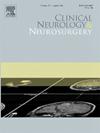Long-term effect of non-invasive brain stimulation on hemispatial neglect, functional outcomes, and mortality after stroke: ELETRON trial extend
IF 1.8
4区 医学
Q3 CLINICAL NEUROLOGY
引用次数: 0
Abstract
Introduction
Our primary clinical trial indicated that anodal stimulation of the right posterior parietal region associated with specific and perceptual task training was superior to placebo in reducing stroke-induced hemispatial neglect (HN) immediately after the treatment protocol. However, our primary study did not investigate whether this benefit was maintained in the long term after stroke. Therefore, this study aimed to evaluate the long-term effects of the protocol applied in the ELETRON trial on outcomes associated with HN, functionality, and mortality.
Methods
This was a pilot, multicenter, prospective, randomized, double-blind trial in patients with HN after stroke who underwent either active tDCS (anodal tDCS or C-tDCS) or sham tDCS in addition to specific and perceptual task training. The outcomes were evaluated on the last day of the session and after 1 year of stimulation (follow-up). Daily evolution rates were calculated as the difference between the values observed between the moments divided by the follow-up time for each individual. The primary outcome was the rate of HN evolution according to the BIT-C scale. The secondary outcome was CBS evolution rate. The exploratory outcomes were the evolution rate of functional disability and autonomy assessed by FIM and BI, quality of life assessed by EQ 5D, stroke severity using the NIHSS, and functional dependence assessed by mRS. Death was examined separately. A linear regression model with a time-adjusted identity link function was used to explain the evolution rates of each outcome of A-tDCS and C-tDCS as a function of sham tDCS. Survival models were adjusted to compare mortality groups.
Results
The evolution rate of BIT-C was not different between A-tDCS (B = 3.18; CI: −4.84–11.19; p = 0.438) and C-tDCS (B = −0.95; CI: −8.97–7.07; p = 0.816) with sham. The secondary and exploratory outcomes showed the same pattern. In addition, there were no statistically significant differences in mortality over time between A-tDCS and S-tDCS (B = 0.322; 95 % CI 0.284–6.707; p = 0.689) and between C-tDCS and S-tDCS (B = −0.798; 95 % CI 0.063–3.195; p = 0.425).
Conclusion
The benefits of A-tDCS and C-tDCS were maintained for all long-term post-stroke outcomes.
Trial registration
RBR-78jvzx - Brazilian Registry of Clinical Trials (Rebec), registered on March 13, 2016.
非侵入性脑刺激对脑卒中后半脑忽视、功能结局和死亡率的长期影响:ELETRON试验扩展。
简介我们的主要临床试验表明,在治疗方案结束后立即对右侧后顶叶区进行阳极刺激,并进行特定和感知任务训练,在减少中风引起的半空间忽略(HN)方面优于安慰剂。然而,我们的主要研究并未调查这种益处是否能在中风后长期保持。因此,本研究旨在评估 ELETRON 试验中应用的方案对 HN、功能和死亡率相关结果的长期影响:这是一项试点、多中心、前瞻性、随机、双盲试验,对象是中风后出现 HN 的患者,他们在接受特定任务和感知任务训练的同时,还接受了主动 tDCS(阳极 tDCS 或 C-tDCS)或假 tDCS。结果在治疗的最后一天和刺激 1 年后(随访)进行评估。每日变化率的计算方法是,每个人在不同时刻观察到的数值之差除以随访时间。主要结果是根据 BIT-C 量表得出的 HN 变化率。次要结果是 CBS 变化率。探索性结果是通过 FIM 和 BI 评估的功能性残疾和自主性演变率、通过 EQ 5D 评估的生活质量、通过 NIHSS 评估的中风严重程度以及通过 mRS 评估的功能依赖性。死亡情况单独进行研究。使用具有时间调整特征联系函数的线性回归模型来解释 A-tDCS 和 C-tDCS 与假 tDCS 的关系中每种结果的演变率。对生存模型进行了调整,以比较死亡率组别:A-tDCS(B = 3.18;CI:-4.84-11.19;p = 0.438)和 C-tDCS(B = -0.95;CI:-8.97-7.07;p = 0.816)与假的 BIT-C 变化率没有差异。次要和探索性结果显示了相同的模式。此外,A-tDCS与S-tDCS(B = 0.322; 95 % CI 0.284-6.707; p = 0.689)以及C-tDCS与S-tDCS(B = -0.798; 95 % CI 0.063-3.195; p = 0.425)之间的死亡率在统计学上没有显著差异:结论:A-tDCS和C-tDCS对中风后所有长期结果的益处得以保持:RBR-78jvzx - 巴西临床试验注册中心(Rebec),2016年3月13日注册。
本文章由计算机程序翻译,如有差异,请以英文原文为准。
求助全文
约1分钟内获得全文
求助全文
来源期刊

Clinical Neurology and Neurosurgery
医学-临床神经学
CiteScore
3.70
自引率
5.30%
发文量
358
审稿时长
46 days
期刊介绍:
Clinical Neurology and Neurosurgery is devoted to publishing papers and reports on the clinical aspects of neurology and neurosurgery. It is an international forum for papers of high scientific standard that are of interest to Neurologists and Neurosurgeons world-wide.
 求助内容:
求助内容: 应助结果提醒方式:
应助结果提醒方式:


